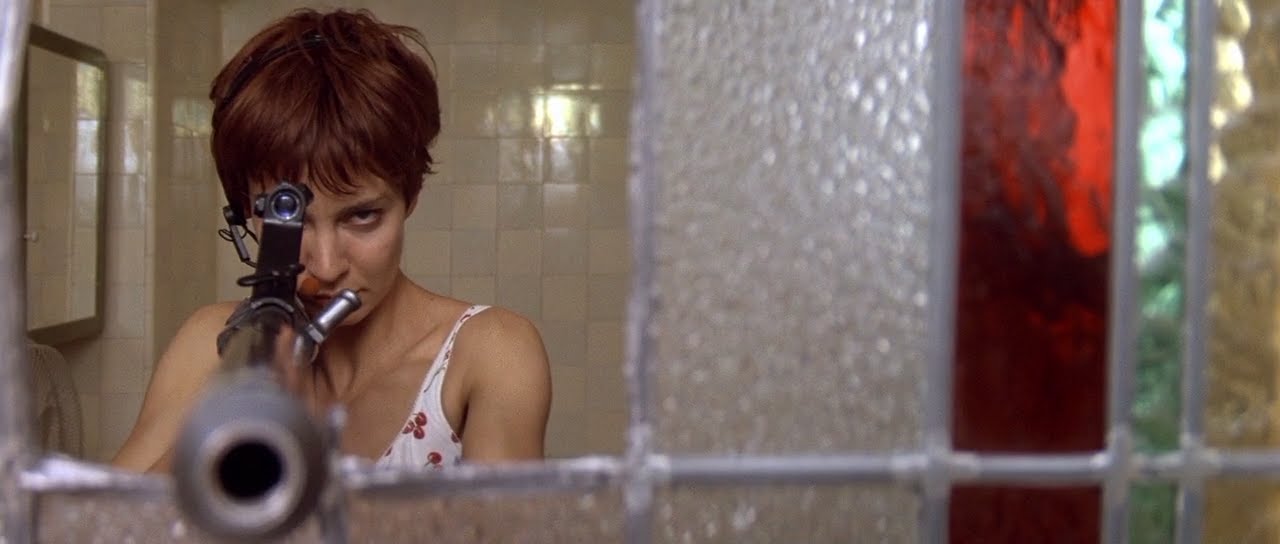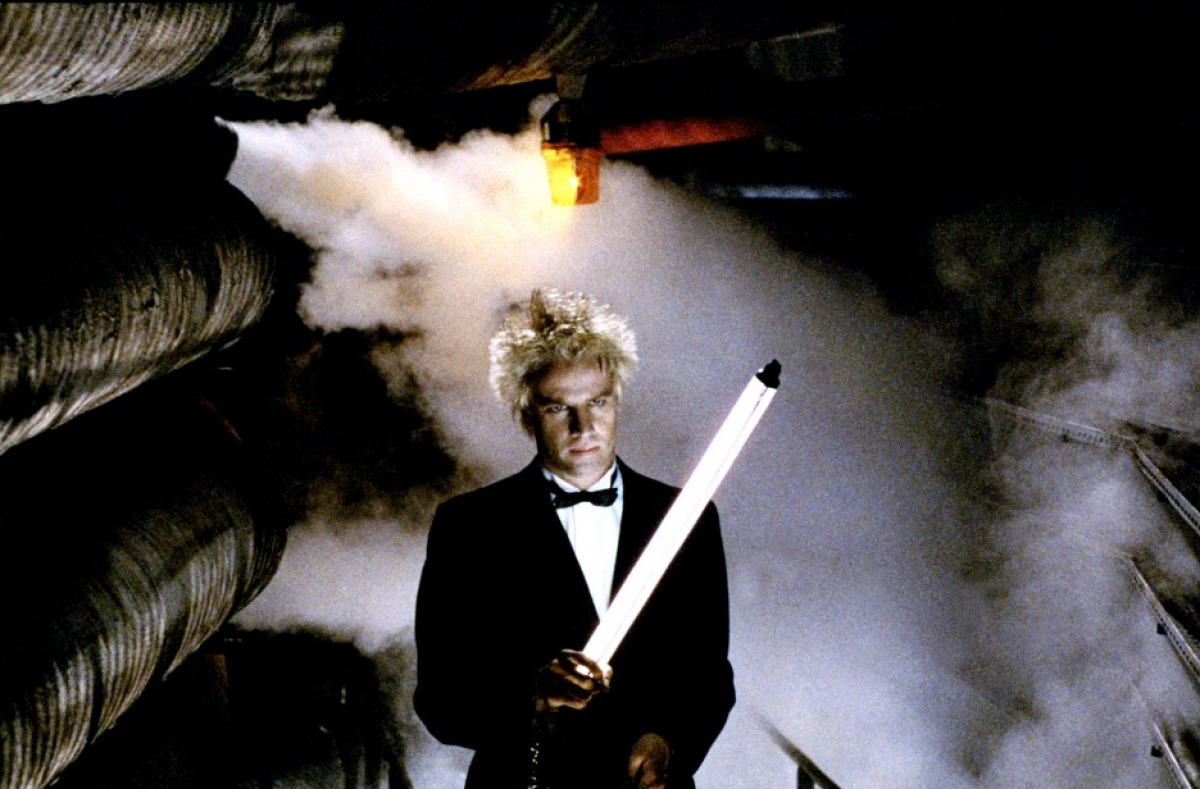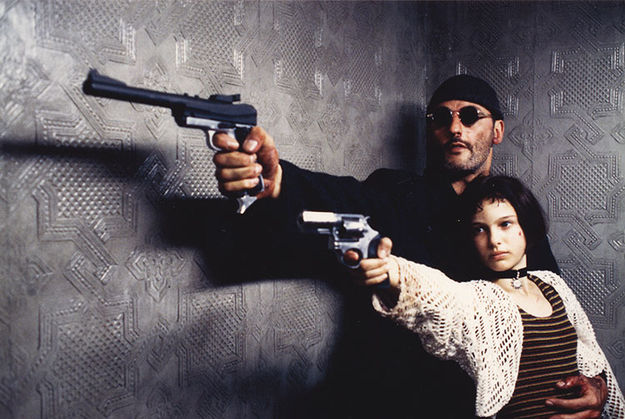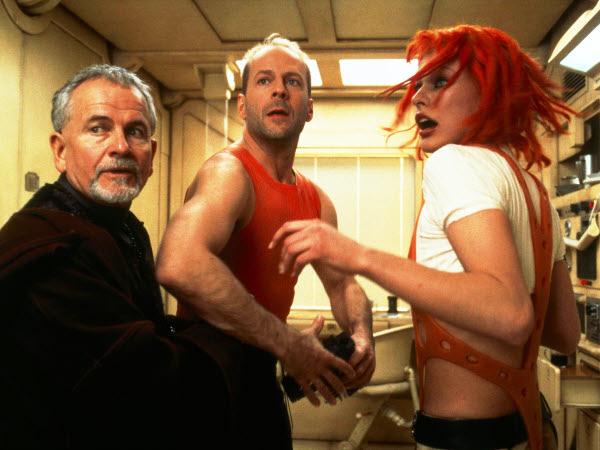4. La Femme Nikita (1990)

One of the most consistently interesting things about Besson as a director (and writer) is the way he vigorously dispenses with such huge amounts of narrative reality in favor of focusing on generating heightened affective (emotional) reality.
It’s not an easy path to travel, but he does it with such conviction that he fairly drags the viewer along with him into the pointedly irrational worlds he creates. A notable element of this world creation is of course the distinctive visuals in Besson’s films, and Nikita marks his first collaboration with cinematographer Thierry Arbogast. Their work together has continued ever since.
In the case of Nikita we venture with Besson deeply into the crime/action genre. Several years after Subway (his previous venture into this generic territory), Besson put together this rather outlandish tale of the titular feral and drug addicted murderess turned secret government assassin (Anne Parillaud).
The film’s opening moments are, in a way, the key to the success of its entire two hours. The gang that Nikita runs with robs a pharmacy to get a fix, and when the break-in goes horribly wrong the ensuing violence is so brutal, protracted, and, yes, realistic in its depiction that as viewers we are wholly prepared to buy into whatever grim realities might come next.
Besson maintains this grim, brutal reality principle for an additional handful of scenes in which Nikita is brought up on charges in court and finally led to her apparent execution by lethal injection.
There are later moments in Nikita, however, where the film teeters on the edge of falling apart under the weight of its own postmodern pastiche of double-life undercover assassin films. The big twist here, of course, is the reformulation of the assassin as a woman, but as the intense realism of the film’s opening scenes gives way to a decreasingly believable scenario, Besson leans more and more into his more familiar territory of heightened emotional fantasies of capital “L” Love as human destiny.
This strange and intoxicatingly entertaining mixture of sublime humanist sentiment and explosive violence is cemented by this film as a Besson trademark, but as we’ll see next he’s struck this balance better before, and will do so even better still in later films.
3. Subway (1984)

This is one of the most brilliantly odd thrillers ever made. Starring Christopher Lambert (best known for his role in the Highlander films) as Fred, a handsome but goofy thief trying to put together a jazz combo in the subways of Paris while simultaneously on the run from one of his victims.
It would be a challenge for most film buffs to find a more absurd scenario, and the absurd cast of characters here is a perfect fit for the crazy story. Besson’s longtime collaborator Jean Reno makes his second appearance here as a nameless drummer. Eric Serra, another longtime collaborator, though usually as the composer of scores for Besson’s films, also appears here as the bassist in Fred’s band.
Then there’s Fred’s love interest Héléna (Isabelle Adjani) who happens to the the wife of Fred’s larceny victim. There’s even a pair of police detectives known only (and, of course, ironically) as “Batman” and “Robin” (Jean-Pierre Bacri and Jean-Claude Lecas).
The degree to which it somehow all manages to cohere is largely thanks to Besson’s creation of the strange subterranean outsider culture in the secret chambers and service tunnels that wind through the Paris Metro.
Each new setting plunges us into another aspect of this surreal parallel universe: from the dark chamber in which the musclebound “Big Bill” (Christian Gomba) frees Fred from his handcuffs, to the smoky party in which Serra’s character introduces himself with a funky slap-bass solo, to the appearance of a purse snatcher known only as “The Roller” (Jean-Hugues Anglade) in a wild roller skating chase scene through tunnels, down escalators and across a boarding platform in front of a speeding train. In short: we learn very early on that we’re meant to set our disbelief firmly to the side and just let it all happen.
As suggested from the opening intertitle (“To be is to do – Socrates, To do is to be – Sartre, Do be do be do – Sinatra”), it’s an extraordinary and ridiculous mixture that brings all sorts of things into collision with each other. With Besson at the helm, it all fits together perfectly to form an incredibly entertaining film that’s certain to charm even the most subtitle resistant viewer (although there’s also an English dubbed version that is better avoided).
2. Léon: The Professional (1994)

Besson’s first American film, this is also one of his best, and an indisputable classic among action movies. As with so many of Besson’s other early works, its success comes in large part from his almost magical sleight of hand in bending and reshaping genre boundaries.
By pairing middle-aged assassin Léon (Jean Reno) with troubled 12-year-old girl Mathilda (Natalie Portman), Besson sets the stage to create an incredible blend of hitman/revenge thriller and coming of age melodrama that is then injected with elements of a police corruption morality play thanks to drug-addled DEA agent Stansfield (Gary Oldman) and mobster capo Tony (Danny Aiello).
Thanks to having this as her first feature film role, Portman (who was indeed only 12 at the time of filming) established herself immediately as not so much a “child actor” but rather an “actor who just happened to be a child.” In many ways this is Portman’s film to carry, and her skill in doing so points clearly toward her later Oscar win at a still relatively young age for Best Actress in Black Swan (2010).
Of her role, it is also worth noting that perhaps because she the is youngest in Besson’s long series of powerful female protagonists, her character is also the least tainted by the uniquely French brand of sexism that always seems to waft gently, for the most part unobjectionably, through the air in his films.
The role, and her exuberant performance in it, has a powerfully affecting maturity to it, and this quality plays perfectly off the stolid and tragic isolation of the titular character. The two characters somehow meet in the middle of their biological age difference to form one of the most complex bonds ever seen in action films that centrally feature a love relationship between leads.
At one point as her relationship with Léon develops, Mathilda even refers directly to Bonnie and Clyde, and there are a number of such moments where their age difference becomes visibly uncomfortable to Léon. Of course as viewers we are led to feel uncomfortable about this as well, yet Besson handles these moments with such skill and delicacy that he is able to reveal through them disarming new layers of his deep humanism.
Of course Oldman’s corrupt DEA agent is the perfect foil for and diabolical enemy of this humanism as his performance balances between comical, scenery chewing outlandishness and grim, glaring heart-of-darkness madness.
1. The Fifth Element (1997)

Besson’s seventh feature is yet another love story, and one of the great classics of SF action cinema. This in part because it so thoroughly establishes the director as one of the great visual stylists in cinema history. While Léon would take the number one spot for dramatic quality, T5E wins overall for its utterly relentless and manic inventiveness. There’s rarely a moment even to catch one’s breath as this movie blasts itself into your head. Even at just over two hours, it feels like it’s over in the blink of an eye.
This is a space opera in the most epic sense, and even goes so far as to frame its climactic action set piece within an actual opera performance by a towering blue alien soprano diva. This self-referential quality within the fabric of T5E spins almost out of control with crazy Easter eggs like a burly female soldier with lopsided Princess Leia hair-buns and even a thinly-veiled Gaumont logo (a French film production company) that sunbursts across the frame as spaceships blast into hyperspace.
Effectively decades in the making since Besson starting drafting the script as a teenager, T5E’s narrative time frame spans centuries. Its intergalactic coordinates span the universe, and its creative team spans not only oceans but also years of Besson’s creative work and interests. All this together with its exhaustive cataloging of Besson’s favorite themes make it border on becoming a fabulously exhausting cinematic pile-up of a film.
Its color scheme spans the visible spectrum and then showers it with glitter. Its costume designs by Jean Paul-Gaultier and visual designs by legendary French comics artists Jean-Claude Mézières (the original mind behind Besson’s upcoming Valerian film) and Jean ‘Moebius’ Giraud pop out so much jaw-dropping eye candy that afterwards you might feel a need to visit either a dentist or an optometrist.
Its pulsing Eric Serra score bombastically supercharges explosive action set pieces one after another. Its precise photographic compositions (with Thierry Arbogast again behind the camera) aid and abet editor Sylvie Landra (who had first worked with Besson on Léon) by visually smoothing out the film’s dense, outrageous parallel-cutting rhythms that routinely leap through vast spaces so that various characters can seamlessly complete each other’s sentences and appear to react to each other across far more forbidden spatial transgressions than the so-called 180° line.
In the medium of film, of course time is of the utmost importance. Yet in The Fifth Element, Besson has the audacity to assert “Time not important. Only life important,” as one of the Mondoshawan guardian aliens says early in the film. In a sense this one line perfectly encapsulates both the apparent contradictions and the perpetually life affirming joy that are both integral to Besson’s early films.
Author Bio: Jim has been a projectionist for over 25 years at the University of Michigan, where he earned his degree in film studies. He has long studied how formal aesthetics affect the creation of potentially life-changing meaning in art forms from film to architecture. He has presented multimedia lectures on anime, and composes experimental electronic music as The Fleshy Timeclock.